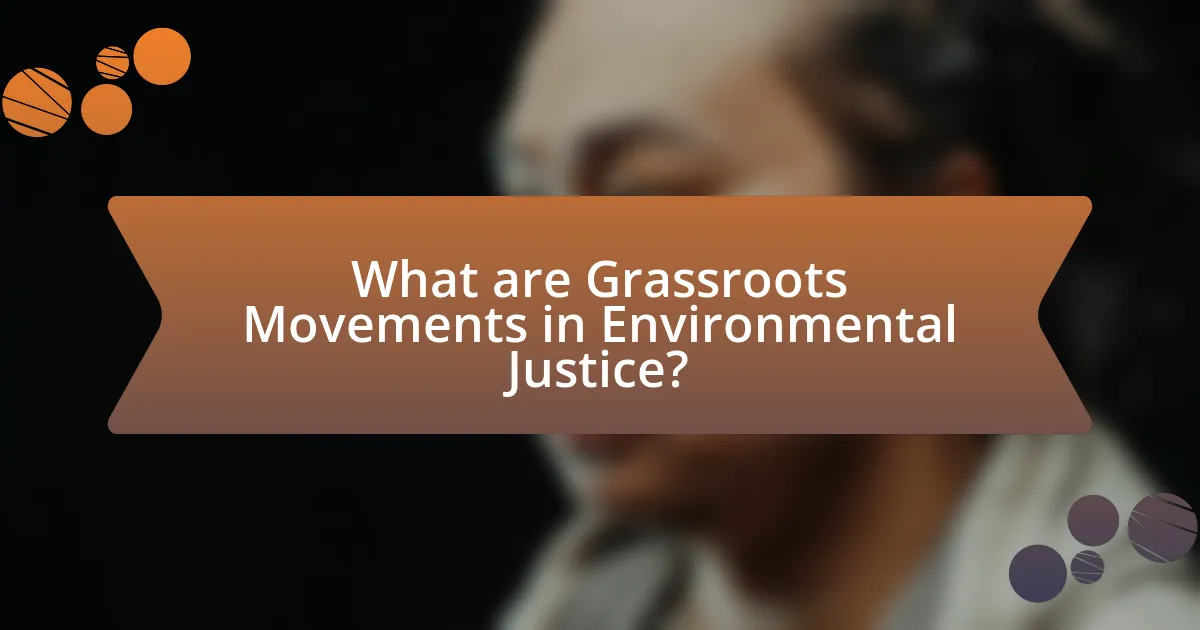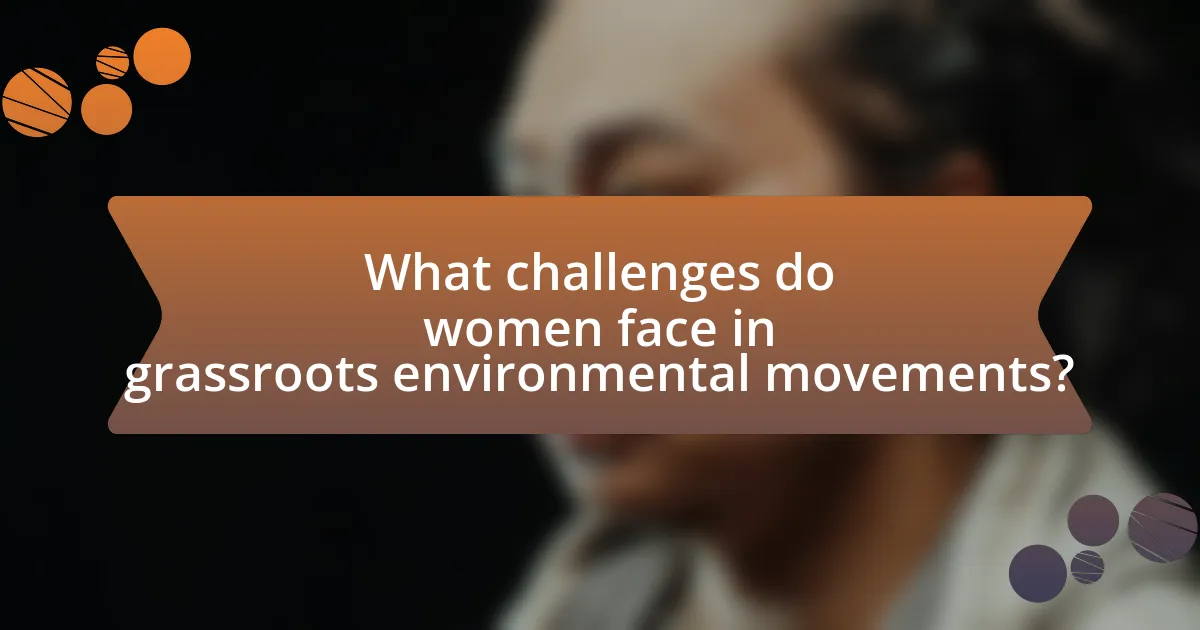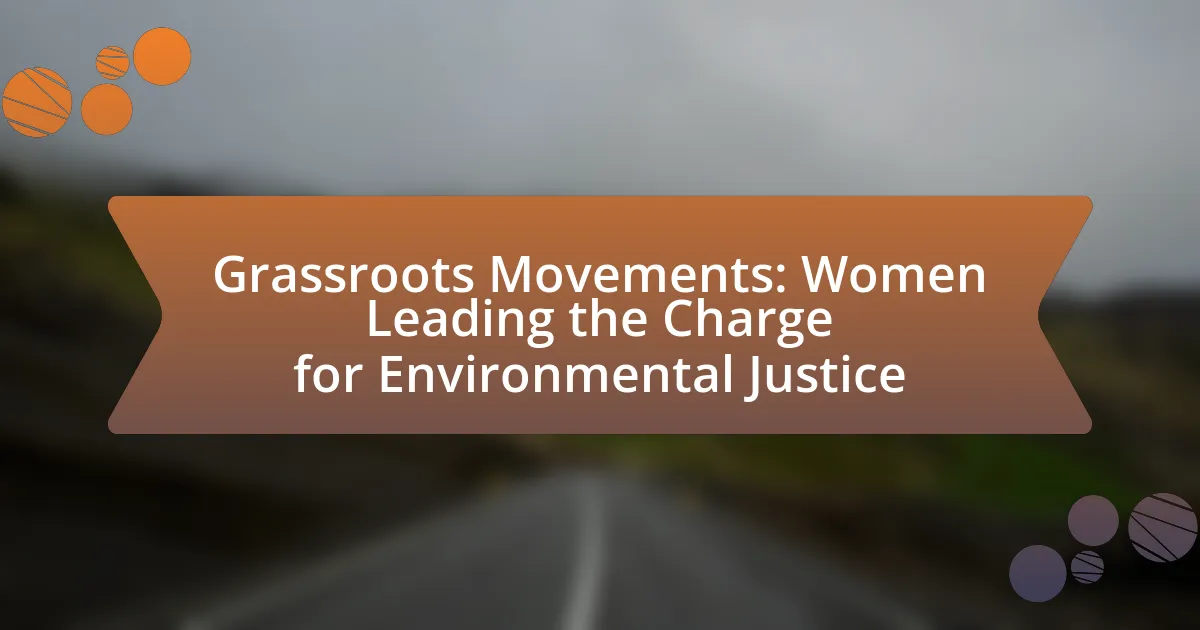Grassroots movements in environmental justice are community-driven initiatives that advocate for equitable environmental policies, particularly for marginalized populations affected by environmental hazards. This article explores the significant roles women play in these movements, highlighting their leadership, community organizing, and advocacy efforts that lead to tangible changes in local environmental practices. It discusses the challenges women face, including gender-based discrimination and limited access to resources, while also showcasing successful examples of women-led initiatives that have achieved environmental justice. Additionally, the article emphasizes the importance of collaboration, innovative strategies, and the lessons learned from these movements that can be applied to other social justice causes.

What are Grassroots Movements in Environmental Justice?
Grassroots movements in environmental justice are community-led initiatives that advocate for equitable environmental policies and practices, particularly focusing on marginalized populations disproportionately affected by environmental hazards. These movements often arise in response to local environmental issues, such as pollution or resource depletion, and aim to empower communities through activism, education, and policy change. For example, the environmental justice movement gained momentum in the United States during the 1980s, highlighted by the 1982 protests against a hazardous waste landfill in Warren County, North Carolina, which mobilized local residents and brought national attention to the issue of environmental racism.
How do grassroots movements empower women in environmental justice?
Grassroots movements empower women in environmental justice by providing them with leadership roles, resources, and a platform to voice their concerns. These movements often prioritize the inclusion of women, recognizing their unique perspectives and experiences related to environmental issues. For instance, organizations like Women’s Earth Alliance have successfully mobilized women to advocate for sustainable practices and policies, leading to tangible changes in local communities. Research indicates that when women are involved in environmental decision-making, there is a higher likelihood of implementing effective conservation strategies, as evidenced by studies showing that women’s participation in community-led initiatives leads to improved environmental outcomes.
What roles do women play in grassroots environmental initiatives?
Women play crucial roles in grassroots environmental initiatives by serving as leaders, advocates, and community organizers. They often mobilize local communities to address environmental issues, raise awareness about sustainability, and implement conservation practices. For instance, studies show that women are more likely to engage in community-based resource management, which enhances biodiversity and promotes sustainable practices. According to the United Nations, women make up a significant portion of the agricultural workforce, and their involvement in environmental initiatives leads to improved food security and resilience against climate change. Their unique perspectives and experiences contribute to more effective and inclusive environmental strategies, demonstrating their vital impact on grassroots movements for environmental justice.
How do these roles differ from traditional environmental leadership?
Grassroots movements led by women differ from traditional environmental leadership by emphasizing community engagement and local activism over institutional approaches. Traditional environmental leadership often relies on established organizations and top-down strategies, whereas grassroots initiatives prioritize grassroots participation, inclusivity, and direct action to address environmental justice issues. For example, women in grassroots movements frequently mobilize their communities to advocate for policy changes that reflect local needs, contrasting with traditional leaders who may focus on broader, less localized environmental policies. This shift towards localized, community-driven efforts has been shown to enhance the effectiveness of environmental advocacy, as evidenced by successful campaigns led by women that have resulted in tangible policy changes at local levels.
Why are grassroots movements important for environmental justice?
Grassroots movements are crucial for environmental justice because they empower marginalized communities to advocate for their rights and influence policy changes. These movements often arise in response to local environmental issues, allowing affected individuals to organize, raise awareness, and mobilize resources effectively. For instance, the environmental justice movement in the United States gained momentum in the 1980s when communities of color protested against toxic waste sites, leading to the establishment of the U.S. Environmental Protection Agency’s Office of Environmental Justice in 1994. This demonstrates how grassroots activism can lead to significant legislative and regulatory changes that address environmental inequalities.
What impact do grassroots movements have on local communities?
Grassroots movements significantly empower local communities by fostering civic engagement and promoting social change. These movements often mobilize individuals around shared concerns, such as environmental justice, leading to increased awareness and advocacy for local issues. For instance, the Women’s Environmental Network has demonstrated how grassroots initiatives can effectively address environmental challenges by organizing community clean-ups and advocating for policy changes that benefit local ecosystems. Research indicates that communities involved in grassroots movements experience enhanced social cohesion and improved access to resources, as seen in the case of the community-led initiatives in Flint, Michigan, which sought to address water contamination issues.
How do grassroots movements influence policy changes?
Grassroots movements influence policy changes by mobilizing community members to advocate for specific issues, thereby creating pressure on policymakers. These movements often utilize strategies such as organizing protests, engaging in public education campaigns, and leveraging social media to raise awareness and build support. For example, the Women’s March in 2017 galvanized millions to advocate for women’s rights and environmental justice, leading to increased political engagement and legislative proposals addressing these issues. Research indicates that grassroots activism can significantly impact local and national policies, as seen in the successful campaigns for climate action led by organizations like 350.org, which have influenced legislation in various countries.

What challenges do women face in grassroots environmental movements?
Women in grassroots environmental movements face significant challenges, including gender-based discrimination, limited access to resources, and inadequate representation in decision-making processes. Gender-based discrimination often manifests in the form of social norms that undermine women’s authority and contributions, making it difficult for them to gain recognition and support. Limited access to financial resources and training opportunities further hampers their ability to lead initiatives effectively. Additionally, women’s voices are frequently marginalized in environmental policy discussions, resulting in a lack of representation that can lead to policies that do not address their specific needs or concerns. These challenges are documented in various studies, such as the United Nations Environment Programme’s report on gender and the environment, which highlights the systemic barriers women face in achieving environmental justice.
How do social and cultural barriers affect women’s participation?
Social and cultural barriers significantly hinder women’s participation in grassroots movements for environmental justice. These barriers manifest as societal norms, stereotypes, and discriminatory practices that limit women’s access to resources, decision-making roles, and leadership opportunities. For instance, research by the United Nations Development Programme indicates that women often face restrictions based on traditional gender roles, which can prevent them from engaging fully in community activism and environmental initiatives. Additionally, cultural stigmas surrounding women’s public involvement can lead to social ostracism, further discouraging their participation.
What specific obstacles do women encounter in leadership roles?
Women encounter several specific obstacles in leadership roles, including gender bias, lack of access to networks, and work-life balance challenges. Gender bias manifests in stereotypes that question women’s competence and authority, often leading to fewer opportunities for advancement. Research from McKinsey & Company indicates that women are less likely to be promoted to managerial positions compared to their male counterparts, with only 28% of senior vice president roles held by women. Additionally, women often face barriers in accessing influential networks that are crucial for career advancement, limiting their visibility and support in leadership contexts. Work-life balance challenges further complicate their leadership journey, as women frequently bear a disproportionate share of family responsibilities, which can hinder their professional growth and availability for leadership roles.
How can these barriers be overcome?
Barriers to women’s leadership in grassroots environmental movements can be overcome through targeted education, community engagement, and policy advocacy. Providing training programs that enhance leadership skills and environmental knowledge empowers women to take active roles in their communities. For instance, initiatives like the Women’s Environmental Network have successfully equipped women with the tools needed to lead local environmental projects. Additionally, fostering partnerships between grassroots organizations and governmental bodies can facilitate access to resources and support, as seen in the collaboration between local women’s groups and environmental agencies in various countries. These strategies not only enhance women’s participation but also create a more inclusive approach to environmental justice.
What strategies have women employed to lead grassroots movements?
Women have employed various strategies to lead grassroots movements, including community organizing, coalition building, and leveraging social media for awareness and mobilization. Community organizing allows women to engage directly with local populations, fostering relationships and understanding specific needs, which has been crucial in movements like the Women’s March. Coalition building enables women to unite diverse groups around common goals, enhancing their collective power, as seen in initiatives like the Global Women’s March for Climate Justice. Additionally, social media platforms have been effectively utilized to disseminate information rapidly, mobilize supporters, and amplify voices, exemplified by campaigns such as #MeToo and #FridaysForFuture, which have garnered global attention and participation. These strategies demonstrate women’s ability to adapt and innovate in grassroots activism, significantly impacting environmental justice movements.
What innovative approaches have women taken to mobilize communities?
Women have employed innovative approaches such as community organizing, digital activism, and participatory decision-making to mobilize communities for environmental justice. For instance, grassroots leaders like Wangari Maathai founded the Green Belt Movement, which not only focused on tree planting but also empowered women through education and economic opportunities, demonstrating the effectiveness of integrating environmental action with community development. Additionally, women have utilized social media platforms to raise awareness and mobilize support for local environmental issues, exemplified by campaigns like #FridaysForFuture, which engage youth and communities globally in climate action. These strategies highlight the critical role women play in fostering community engagement and driving collective action for environmental justice.
How do collaboration and networking enhance their efforts?
Collaboration and networking significantly enhance grassroots movements by fostering resource sharing, amplifying voices, and increasing collective impact. When women in environmental justice movements collaborate, they pool their skills, knowledge, and resources, which leads to more effective strategies and solutions. For instance, networks can connect local activists with national organizations, providing access to funding, training, and broader platforms for advocacy. Research indicates that collaborative efforts can lead to a 30% increase in project success rates, as seen in various environmental initiatives where diverse groups unite for common goals. This synergy not only strengthens individual efforts but also creates a more formidable force against systemic issues, ultimately driving meaningful change in environmental justice.

What are some successful examples of women-led grassroots movements?
Some successful examples of women-led grassroots movements include the Women’s Environmental Network in the UK, which focuses on environmental justice and sustainability, and the Chipko Movement in India, where women played a crucial role in forest conservation by hugging trees to prevent deforestation. The Women’s Environmental Network has mobilized women to advocate for policies that address environmental issues affecting their communities, while the Chipko Movement, initiated in the 1970s, successfully led to the protection of forests and raised awareness about environmental conservation. These movements demonstrate the significant impact women can have in grassroots activism for environmental justice.
How have these movements achieved environmental justice?
Grassroots movements led by women have achieved environmental justice by mobilizing communities to advocate for equitable environmental policies and practices. These movements have successfully highlighted the disproportionate impact of environmental degradation on marginalized communities, particularly women and children, thereby influencing policy changes. For instance, the Women’s Earth and Climate Action Network has played a crucial role in raising awareness about climate change and its effects on vulnerable populations, leading to increased representation of these communities in environmental decision-making processes. Additionally, grassroots campaigns have resulted in legal victories, such as the recognition of the rights of nature in various jurisdictions, which directly supports environmental justice initiatives.
What specific outcomes have resulted from these movements?
Grassroots movements led by women for environmental justice have resulted in significant policy changes, increased awareness of environmental issues, and enhanced community resilience. For instance, the Women’s Earth and Climate Action Network has successfully influenced climate policy at local and international levels, advocating for sustainable practices and equitable resource distribution. Additionally, these movements have mobilized communities to engage in grassroots activism, leading to the establishment of protected areas and the implementation of sustainable agricultural practices. The outcomes are evidenced by the adoption of the Paris Agreement, where women’s voices were integral in shaping climate commitments, highlighting the critical role of grassroots activism in driving systemic change.
How can these examples serve as models for future initiatives?
These examples can serve as models for future initiatives by demonstrating effective strategies for mobilizing communities and advocating for environmental justice. Grassroots movements led by women have shown that localized efforts can create significant change, as evidenced by the success of initiatives like the Women’s Earth Alliance, which empowers women to lead sustainable practices in their communities. Such models highlight the importance of inclusive leadership and collaboration, which can enhance the effectiveness of future environmental campaigns. Additionally, the documented impact of these movements on policy changes, such as the recognition of indigenous rights in environmental legislation, provides a clear framework for future initiatives to follow.
What lessons can be learned from women leading grassroots movements?
Women leading grassroots movements demonstrate the importance of community engagement and collaboration in driving social change. Their leadership often emphasizes inclusivity, ensuring that diverse voices are heard and represented, which strengthens the movement’s impact. For instance, the work of women in the environmental justice movement, such as Wangari Maathai with the Green Belt Movement, illustrates how grassroots initiatives can mobilize communities around sustainable practices and environmental protection. Additionally, studies show that women-led movements tend to prioritize long-term solutions over short-term gains, fostering resilience within communities. This approach is evident in the success of initiatives like the Women’s Earth Alliance, which empowers women to address environmental issues locally while building global networks of support.
How can these lessons be applied to other social justice causes?
The lessons learned from grassroots movements led by women in environmental justice can be applied to other social justice causes by emphasizing community engagement, intersectionality, and the importance of local knowledge. For instance, the success of women-led initiatives in mobilizing communities around environmental issues demonstrates the effectiveness of grassroots organizing, which can similarly empower movements addressing racial, economic, or gender inequalities. Research shows that grassroots efforts often lead to more sustainable and inclusive solutions, as seen in the work of organizations like the Women’s Earth Alliance, which highlights the role of women in advocating for environmental and social change. By adopting these strategies, other social justice movements can enhance their impact and foster broader coalitions.
What best practices can be adopted by emerging leaders?
Emerging leaders can adopt best practices such as active listening, fostering collaboration, and prioritizing inclusivity. Active listening enables leaders to understand diverse perspectives, which is crucial in grassroots movements focused on environmental justice. Fostering collaboration encourages teamwork and collective problem-solving, essential for addressing complex environmental issues. Prioritizing inclusivity ensures that all voices, particularly those of marginalized communities, are heard and valued, enhancing the effectiveness of leadership in advocating for environmental justice. These practices are supported by research indicating that inclusive leadership leads to better decision-making and more sustainable outcomes in community-driven initiatives.
What practical steps can individuals take to support women in grassroots movements?
Individuals can support women in grassroots movements by actively participating in their initiatives, such as volunteering time, donating resources, or amplifying their voices through social media. Engaging in local events organized by these movements fosters community support and raises awareness about their causes. For instance, research shows that grassroots organizations led by women often face funding disparities; thus, financial contributions can significantly enhance their capacity to effect change. Additionally, individuals can educate themselves and others about the specific challenges these women face, which helps build a more informed and supportive community. By taking these practical steps, individuals contribute to the empowerment and visibility of women leading grassroots efforts for environmental justice.
